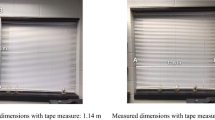Abstract
Fuel load is a crucial parameter for evaluating design fires for buildings. However, the availability of fuel load data is currently hindered by the lack of an efficient on-site data collection method. This research develops a new methodology for fuel load surveys that can facilitate the collection, storage, and analysis of fuel load data for a variety of building occupancies. The new survey method harnesses recent developments in mobile electronic devices, cloud storage, and machine vision to efficiently complete fuel load surveys in buildings. A four-step method is developed comprising digital inventory, data organization, item matching through computer vision, and fuel load estimation. The method is completed through an interactive electronic surveying form accessible on any mobile device with an internet connection, such as a tablet. The application allows taking digital measurements and pictures of the room and content, which are stored, and later searched through retail search engines using image recognition. Automatic matching of the picture with an online catalogue item gives access to further information about this item which are then used to evaluate the item fuel load, using a table of materials calorific values coded in the application. A wide adoption of this method could provide benefits by progressively populating such digital fuel load database. The results can then be used to provide design guidelines for fuel load density in codes and standards, for application in performance-based design of structures in fire.








Similar content being viewed by others
References
SFPE (Society of Fire Protection Engineers) (2016) The SFPE handbook of fire protection engineering, M. J. Hurely Editor in Chief, 5th edn. Springer, Berlin
NFPA (2002) NFPA 557 Standard for determination of fire loads for use in structural fire protection. National Fire Protection Association, Quincy
Kerber S (2012) Analysis of changing residential fire dynamics and its implications on firefighter operational timeframes. Fire Technol 48:865–891
Jonsdottir A, Rein G (2009) Out of range. Fire Risk Manag 12:14–17
Elhami-Khorasani N, Salado Castillo JG, Saula E, Josephs T, Nurlybekova G, Gernay T (2020) Application of a digitized fuel load surveying methodology to office buildings. Fire Technol. https://doi.org/10.1007/s10694-020-00990-2
Zalok E (2011) Validation of methodologies to determine fire load for use in structural fire protection. In: Final report prepared for the Fire Protection Research Foundation, Carleton University, Ottawa, Canada
Caro T, Milke J (1996) A survey of fuel loads in contemporary office buildings. NIST-GCR-96-697, National Institute of Standards and Technology, Gaithersburg
Culver C, Kushner J (1975) A program for survey of fire loads and live loads in office buildings. NBS technical note 858, Gaithersburg, MD
Cornell C (1972) Office live loads program formulation. National Bureau of Standards, Washington, DC
Culver C (1976) Survey results for fire loads and live loads in office buildings. National Bureau of Standards, Washington DC
Gross D (1977) Measurements of fire loads and calculations of fire severity. Wood Fiber 9(1):72–85
Kumar S, Kameswara Rao C (1997) Fire loads in office buildings. J Struct Eng 123(3):365–368
Hadjisophocleous G, Zhengrong C (2010) A survey of fire loads in elementary schools and high schools. J Fire Prot Eng 20(1):55–71
VKF and AEAI (2007) Note explicative de protection incendie - Evaluation en vue de la determination de la grandeur des compartiments coupe-feu. Vereinigung Kantonaler Feuerversicherungen (VKF) and Association des établissements cantonaux d’assurance incendie (AEAI)
Thauvoye C, Zhao B, Klein J, Fontana M (2008) Fire load survey and statistical analysis. In: Fire safety science—proceedings of the 9th international symposium, pp 991–1002
Barnett A, Horasan M, He Y (2017) Fire resistance level assessments in buildings and development of appropriate input data. In: Fire Australia conference and trade show, pp 113–133, May 2017
Bwalya A, Sultan M, Bénichou N (2004) A pilot survey of fire loads in Canadian homes. National Research Council Canada, Ottawa
Bwalya A, Lougheed G, Kashef A, Saber H (2011) Survey results of combustible contents and floor areas in Canadian multi-family dwellings. Fire Technol 47:1121–1140
IBC (2012) International building code. International Code Council, Country Club Hills
Janssens M (2016) Calorimetry. In: SPFE handbook of fire protection engineering, 5th edn. Springer, Berlin, pp 905–951
Fontana M, Kohler J, Fischer K, De Sanctis G (2016) Fire load density. In: SPFE handbook of fire protection engineering, 5th edn. Springer, Berlin, pp 1131–1142
CIB W14 (1986) Design guide—structural fire safety. Fire Saf J 10(2):77–137
CEN (European Committee for Standardization) (2002) Part 1–2 general actions—actions on structures exposed to fire, Eurocode 1, Brussels, Belgium
Armstrong GT, Domalski ES, Keane TR (1974) Combustion fundamentals for waste incineration. The American Society of Mechanical Engineers, New York City, pp 143–182
Babrauskas V, Harris RH, Gann RG, Levin BC, Lee BT, Peacock RD, Paabo M, Twilley W, Yoklavich MF, Clarck HM (1988) Fire hazard comparison of fire-retarded and non-fire-retarded products. NBS Special Publication 749, National Bureau of Standards, Washington, DC
Babrauskas V, Grayson SJ (1992) Heat release in fires. Elsevier Science, Reprinted by Chapman and Hall, Great Yarmouth
Benisek L (1974) Improvement of the natural flame retardants of wool, part I: metal-complex applications. J Text Inst 65:102–108
Biyson JO, Gross D (1967) Techniques for the survey and evaluation of live floor loads and fire loads in modem office buildings. National Bureau of Standards, Washington, DC
Buchanan AH, Abu AK (2017) Structural design for fire safety, 2nd edn. Wiley, West Sussex
Butcher EG, Parnell AC (1983) Design for fire safety. Wiley, West Sussex
Chamberlain DL (1983) Heat release rates of lumber and wood products. In: Schaffer EL (ed) Behavior of polymeric materials in fires. ASTM STP 816, American Society for Testing and Materials, West Conshohocken, pp 21–41
Drysdale D (1998) An introduction to fire dynamics, 2nd edn. Wiley, West Sussex
SFPE (Society of Fire Protection Engineers) (1995) The SFPE handbook of fire protection engineering, 2nd edn, Quincy, MA
Huggett C (1980) Estimation of rate of heat release by means of oxygen consumption calorimetry. Fire Mater 4(2):61–65
Ingberg SH, Dunham JW, Thompson JP (1957) Combustible contents in buildings. In: Building materials and structures report 149, National Bureau of Standards, Washington, DC
ISO (International Organization for Standardization) (2007) Life-threatening components of fire - guidelines for the estimation of time available for escape using fire data, ISO 13571 Geneva
Issen LA (1980) Single-family residential fire and live loads survey. NBSIR 80-2155, National Bureau of Standards, Washington, DC
Krasny J, Parker W, Babrauskas V (2001) Fire behavior of upholstered furniture and mattresses. William Andrew Pub, Boston
McGrattan K, Klein B, Hostikka K, Floyd J, Baum H, Rehm H, Mell W, McDermott R (2008) Fire dynamics simulator technical reference guide, volume 1: mathematical model, NIST Special Publication 1018-5, pp 1–92. National Institute of Standards and Technology, Gaithersburg
Acknowledgements
The authors gratefully acknowledge the Fire Protection Research Foundation (FPRF) and the National Fire Protection Association (NFPA) for their generous support. The FPRF generously provided funding and guidance for this research Project. The authors would like to thank Amanda Kimball from NFPA, and appreciate the efforts of the project technical panel who consisted of experts from different parts of the industry as follows: Craig Beyler, Jensen Hughes (retired); Florian Block, BuroHappold; Richard Davis, FM Global; Dave Frable, General Services Administration; Matt Hoehler, NIST; Chris Jelenewicz, SFPE; Kevin LaMalva, Simpson Gupertz & Heger; Drew Martin, Holmes Fire Safety; Margaret McNamee, Lund University; Brian Meacham, Meacham Associates; Jim Milke, University at Maryland; Steve Wolin, Reliable Automatic Sprinkler; Valeria Ziavras, NFPA staff liaison; Baran Ozden, NFPA staff liaison.
Author information
Authors and Affiliations
Corresponding author
Additional information
Publisher's Note
Springer Nature remains neutral with regard to jurisdictional claims in published maps and institutional affiliations.
Rights and permissions
About this article
Cite this article
Elhami-Khorasani, N., Salado Castillo, J.G. & Gernay, T. A Digitized Fuel Load Surveying Methodology Using Machine Vision. Fire Technol 57, 207–232 (2021). https://doi.org/10.1007/s10694-020-00989-9
Received:
Accepted:
Published:
Issue Date:
DOI: https://doi.org/10.1007/s10694-020-00989-9




